Mint is a strong plant that copes with tough conditions. It’s known for its clean, fresh scent and propensity to run wild in a flower border, but whether it’s added to plain water, dessert, or left to feed our essential pollinators, this pungent and flavorsome plant is a winner. However, despite its tough nature and easy-grow character, mint sometimes dies mid-life. It’s frustrating, so here are eleven reasons why your mint plant keeps dying and how to revive it.
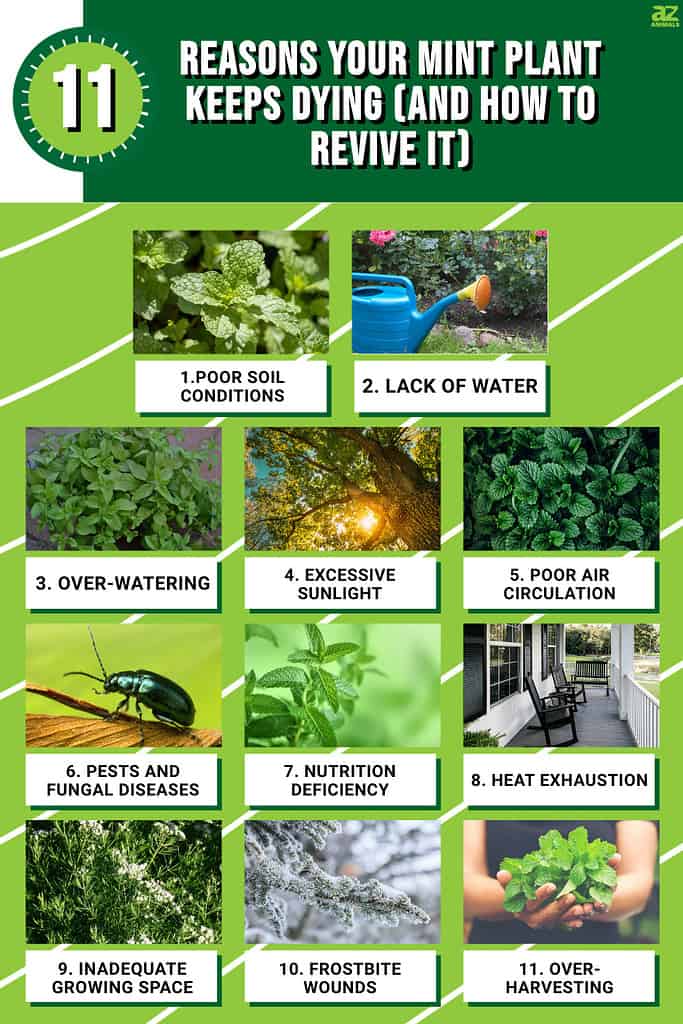
1. Poor Soil Conditions
Mint enjoys well-drained soil, but that doesn’t mean sandy or chalky soil is adequate. Fertile, well-drained soil is important because mint won’t receive the nutrients it needs without rich organic content.
Without nutrients, mint dies. It’s really that simple! Many people plant mint in a container because its evasive roots invade a flower border within months, but mint is hungry and uses nutrients quickly. Unless container soil is replenished frequently, mint doesn’t stand a chance there.
Mint growing in poor soil appears sickly, yellow, and stunted with few leaves.
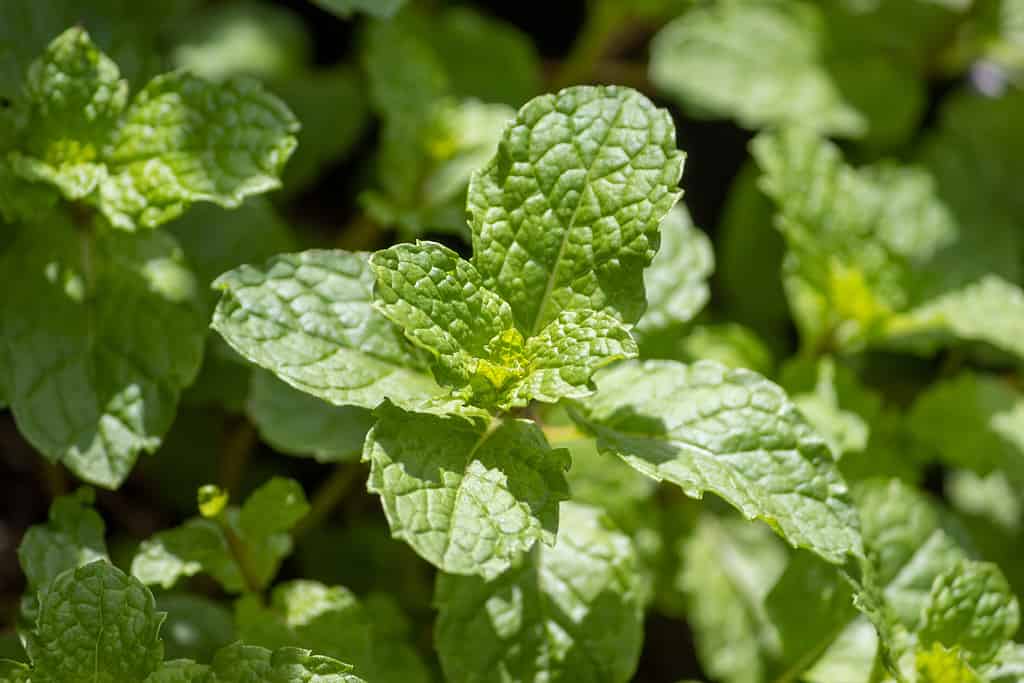
Poor soil is a top reason why nutrition-hungry mint keeps dying.
©Leo Herdy/Shutterstock.com
2. Lack of Water
Mint grows best in damp, moist soil. In its native environment, mint is found in shady glades, near rivers, lakes, ponds, or other damp environments. This means lack of water in a cultivated yard hits mint hard.
Dehydration problems particularly hit container-grown mints because containers dry out so quickly. Even if rain falls, it won’t sufficiently drench a container to keep mint from dying. Mint needs a deep watering at least once a day during spring and summer.
Dehydrated mint turns brown and crispy, and its leaves fall off in a shower of dust.
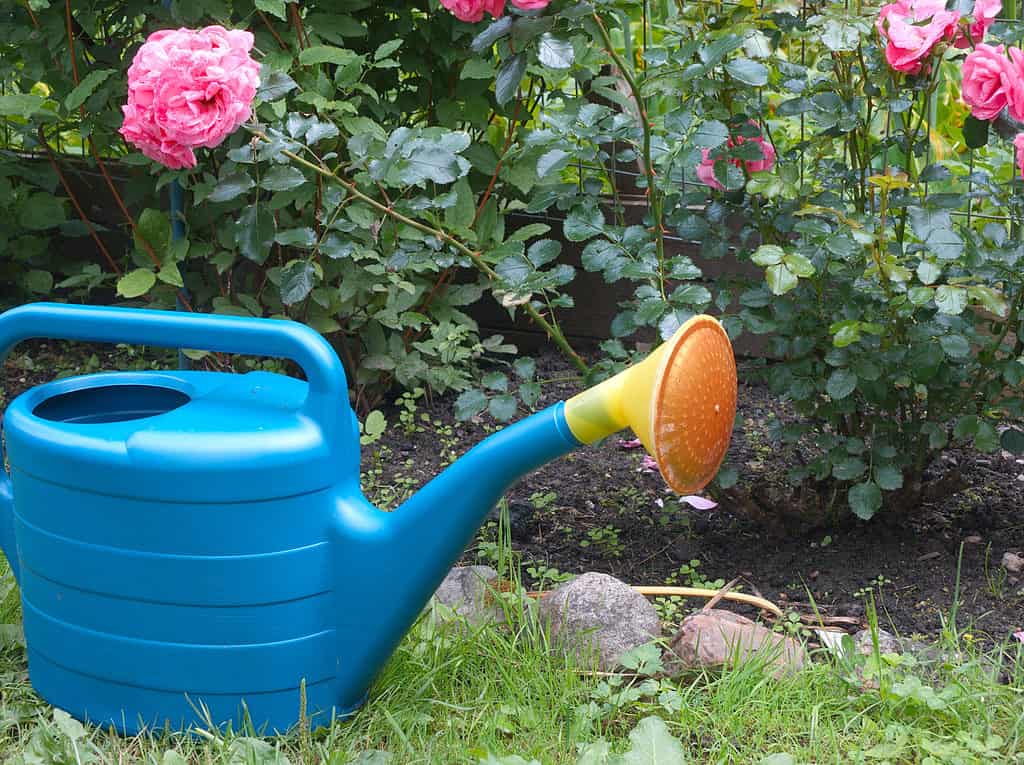
Consistent watering is required for the mint to thrive.
©iStock.com/victorass88
3. Over-Watering
Conversely, over-watering kills mint, too!
This usually occurs when a container (or poorly drained flower bed) traps water around its roots. Mint needs water, soil, and oxygen in its roots to live. That’s why fertile but well-drained soil is important. Consistently soggy soil leads to root rot and a dead mint plant.
Another issue with overwatering is that it encourages fungal diseases. Fungus needs damp conditions to thrive, and an overwatered, soggy pot of compost with drenched foliage is ideal. When you water mint, add water to the soil, not the foliage, to avoid mildew.
Mint suffering from too much water looks wilted and brown, and its foliage turns slimy.

Excessive watering and poor drainage rots mint roots and quickly kills the plant.
©Edita Medeina/Shutterstock.com
4. Excessive Sunlight
We’ve seen that wild mint thrives in damp and shady locations, so it’s not a surprise that excessive sunlight kills mint.
Shade-loving mint prefers morning sunshine on its leaves because it dries out overnight dew and stops fungus in its tracks. Afternoon or evening sun burns its foliage, turning it crispy and encouraging an early death.
Dying mint that’s frying away in the midday sunshine has brown crisped leaves and blackened stems.

Mint can’t cope with too much direct sun. It prefers shade and damp soil.
©iStock.com/bruev
5. Poor Air Circulation
Mint that receives enough shade and water may still suddenly die. This is really frustrating!
Poor air circulation is one of the most under-recognized reasons for a dying mint plant. Densely-foliaged mint needs fresh air circulating its leaves to prevent condensation and humidity, which lead to fungal infections.
A mint plant with poor air circulation usually turns yellow and dusty before defoliating.
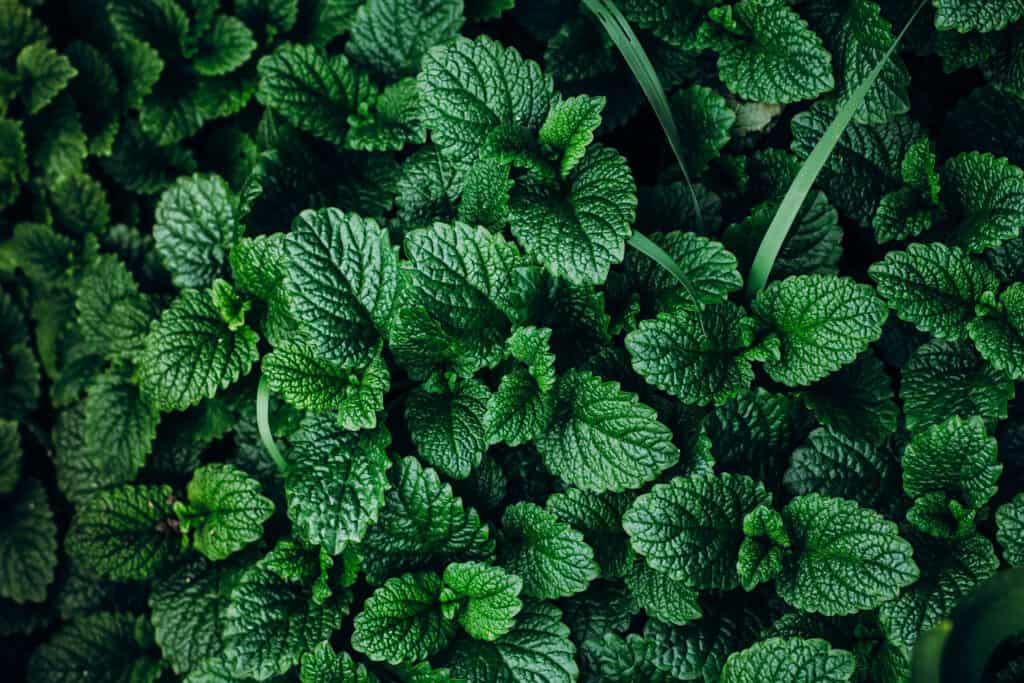
Healthy mint leaves grow with plenty of air circulation. Leave 18-24 inches between each plant.
©AnikonaAnn/Shutterstock.com
6. Pests and Fungal Diseases
Although mint is a companion plant to fend off aphids and other sap-sucking insects, some pests have evolved to eat mint. One of the most prevalent is the pesky flea beetle. They’re easy to identify because, despite their tiny proportions, they jump and ping over the place when you shake a mint stem.
Fungus chiefly presents as dusty gray, yellow, or brown patches. Deformed shoots, pale foliage, and black bumps all signify fungus.

Flea beetles infest mint plants. Treat them with a bar of dish soap and water spray every morning.
©InsectWorld/Shutterstock.com
7. Nutrition Deficiency
Poor soil condition leads to nutrition deficiency, as does a failure to fertilize your hungry mint.
Regularly harvested mint plants desperately need fertilizer to grow back their foliage. Without fertilizer, mint plants can’t grow enough foliage to photosynthesize their nutrients, so they die.
But hold off on that liquid feed for just a second because it’s possible to over-fertilize mint, too. In the worst case, too much fertilizer kills it, but too many weak applications and mint puts on lots of sappy, soft growth that attracts flea beetles.
Nutrition-deficient mint appears stunted, turns yellow, and won’t flower.
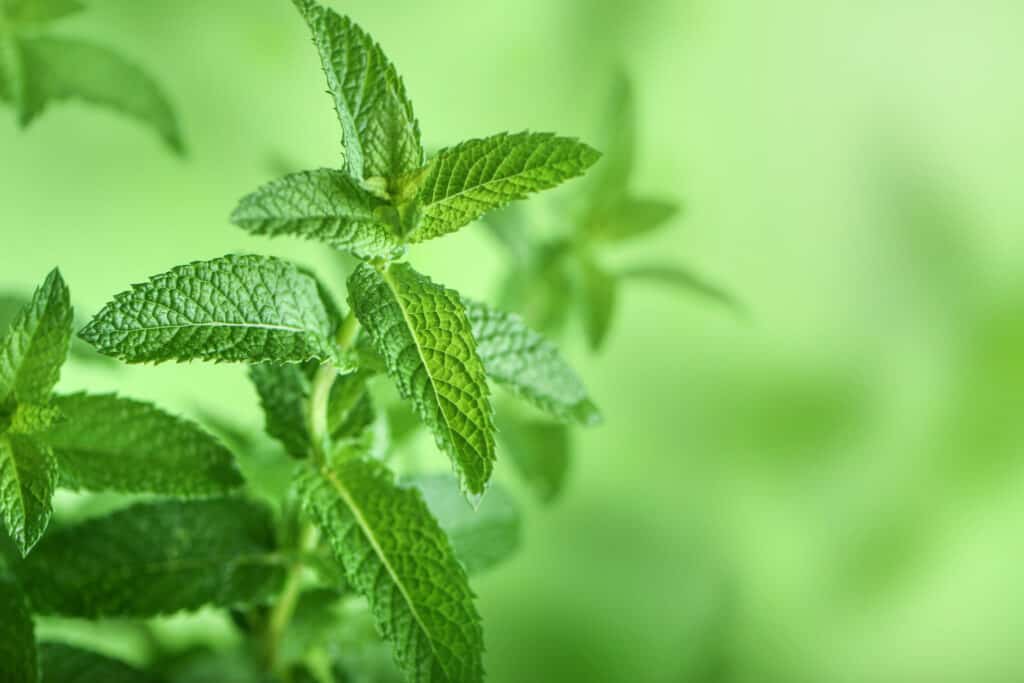
Nutrition deficiency leads to stunted and yellowing mint foliage.
©OleStudio/Shutterstock.com
8. Heat Exhaustion
Aromatic, tasty mint enjoys cool and damp conditions. We’ve seen that too much direct sun scorches its foliage, but heat exhaustion can also come from simple heat, even in the shade. For example, mint in a greenhouse, cold frame, or a sun-trap porch can overheat and die.
Signs of a minty heatstroke include limp stems and crispy leaves a few days later.

Mint plants enjoy a shady porch but beware of heat traps.
©Ursula Page/Shutterstock.com
9. Inadequate Growing Space
Mint needs room to grow. In the wild, mint is large enough to reach several feet in all directions, and it’s never forgotten this!
Cramped mint suffers from nutrition deficiency, poor air circulation, and dehydration. It’s not made to compete, so give it plenty of room to stretch out. At least 18-24 inches between each plant, depending on the species — check its growing label.
Mint plants struggling for space appear yellowed, stunted, and browned before they die.

Like this mountain mint, wild mint needs lots of space to grow.
©I, SB Johnny / CC BY-SA 3.0, via Wikimedia Commons – Original / License
10. Frostbite Wounds
Mint likes cool, moist conditions, and it’s pretty cold hardy. Generally speaking, mint can cope with frost and sub-zero temperatures, but prolonged snowfall can damage its stems.
Some of the prettier cultivars struggle with cold more than native plants do. A snap freeze can kill those cultivars outright.
Frostbite wounds appear black and pitted. They usually appear on stems.
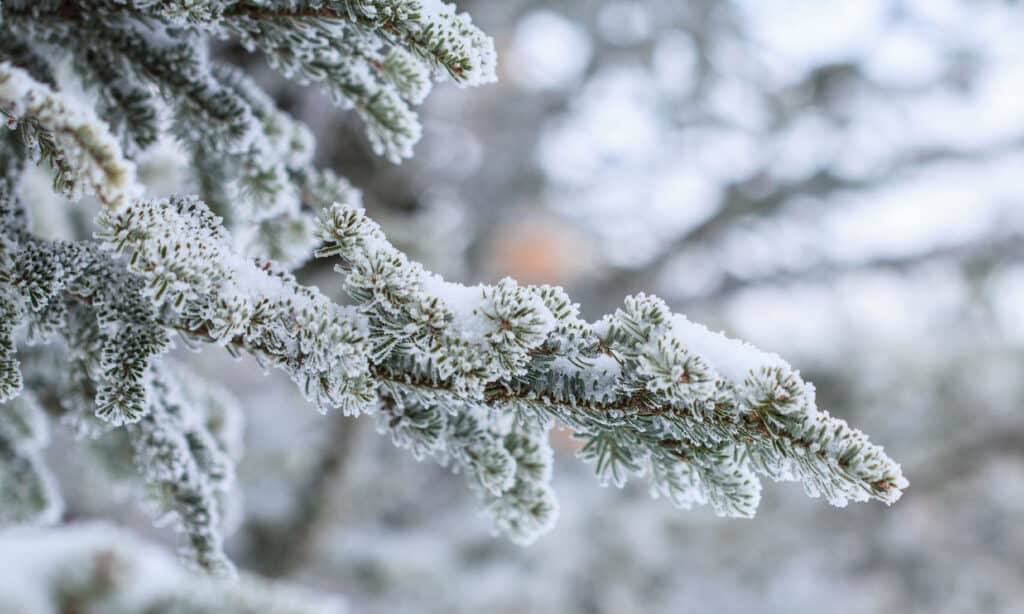
Mint is cold hardy, but prolonged snow and sub-zero temperatures may cause frostbite damage.
©Gary C. Tognoni/Shutterstock.com
11. Over-Harvesting
Part of growing your own is the harvest excitement. Garnishing a round of margaritas with homegrown mint, filling the Pimms jug, and chopping Sunday roast’s mint sauce are just a few ways to use mint.
However, mint is a living plant that won’t cope with rapid and complete defoliation. Stripping a mint bare is one of the reasons why your mint keeps dying.
Harvest mint by the stem. Cut sections of stem just above a set of leaves with sharp scissors. This lets the lower section regenerate.
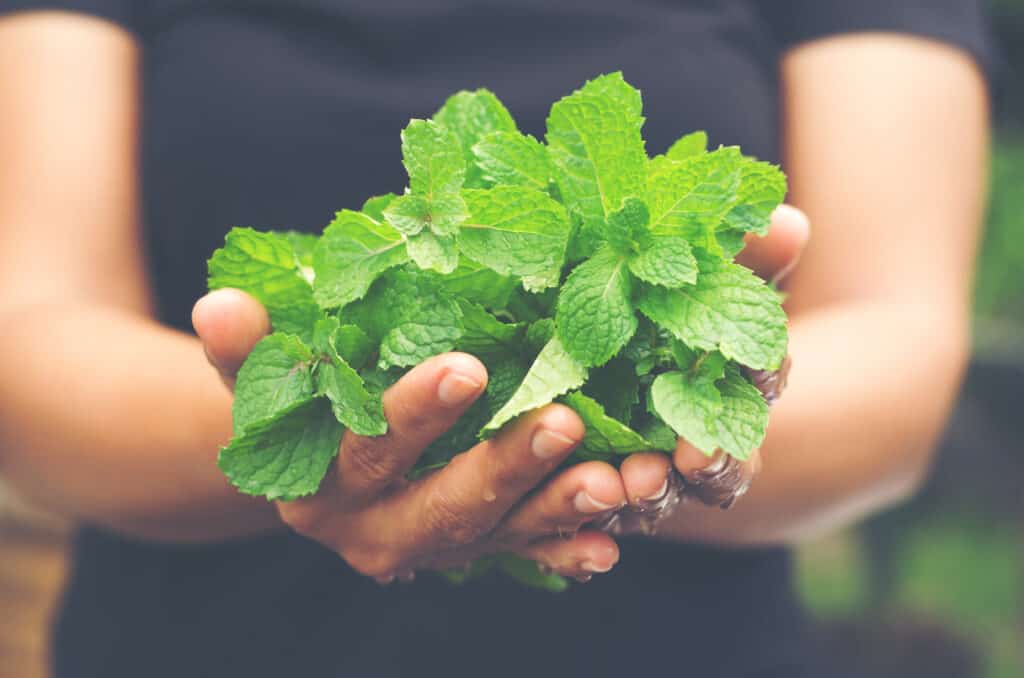
Overharvesting mint is one of the main reasons why your mint plant keeps dying.
©Cat Act Art/Shutterstock.com
How to Revive Dying Mint
“Identify what is making your mint die and rectify it” sounds simple, but mint keeps dying for several reasons. If yours is mid-death, you might save it this way:
- Take the mint from its container and halve the root ball with a sharp spade so you have two new plants.
- Place the new plants in separate containers with plenty of drainage holes.
- Add lots of fresh, fertile soil.
- Cut down all stems to the first pair of leaves.
- Water it thoroughly (unless you’ve over-watered, in which case leave it to dry out first).
- Apply appropriate fertilizer, such as liquid seaweed.
- Use commercial pesticides suitable for edible plants to deal with flea beetles, or try a spray-on mixture of dish soap and water twice a day.
- Place it in a spot that catches the morning sun but provides shade during the afternoon.
- Ensure lots of air circulation.
Going forward, thoroughly water your mint once a day, fertilize it weekly in the growing season, and harvest with care.
Flea beetles may force an encore, in which case you can treat them with dish soap and water spray. In cold snaps, cover mint with horticultural fleece.
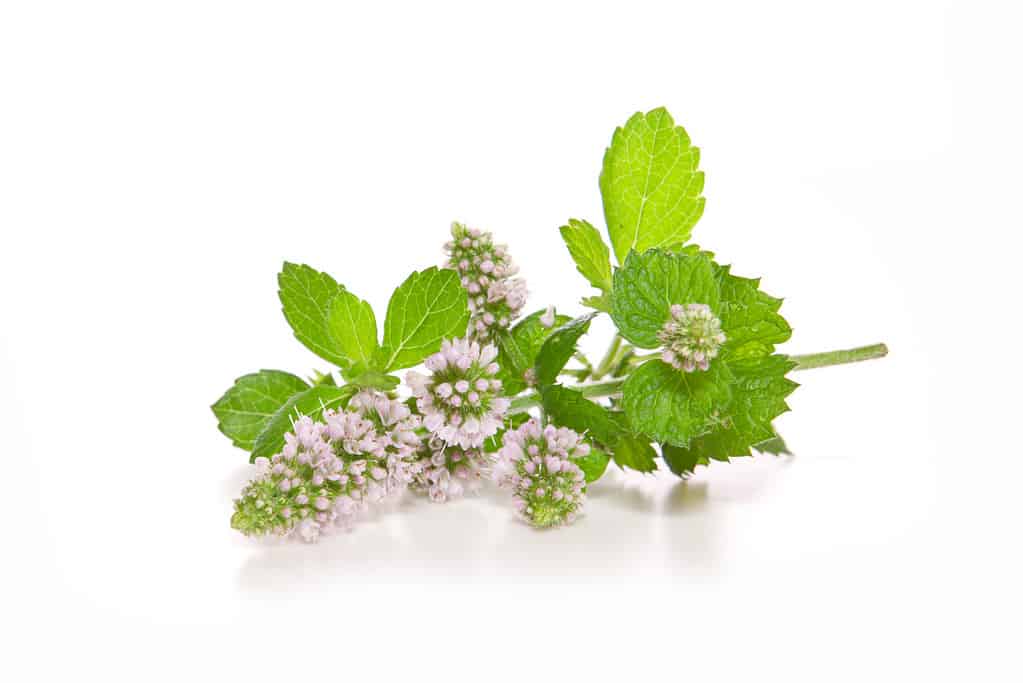
Peppermint is one of the hardiest mints to grow in the U.S.
©Swetlana Wall/Shutterstock.com
The Hardiest Mint Plants
If you’re following the tips above, but your mint just keeps on dying, try swapping to a hardier variety that suits your USDA plant hardiness zone. Some of the best mint plants for the U.S. include:
- Spearmint – often sold as garden mint or Mentha spicata
- American wild mint – Mentha canadensis
- Peppermint – Mentha x piperita
- Long-leaved mint – Mentha longifolia
- Apple mint – Mentha suaveolens
- Chocolate peppermint – Mentha x pipertia f. citrate ‘Chocolate’
- Moroccan mint – Mentha spicata var. crispa ‘Moroccan’
Summary of 11 Reasons Your Mint Plant Keeps Dying
| Reason | |
|---|---|
| 1. | Poor Soil Conditions |
| 2. | Lack of Water |
| 3. | Over-Watering |
| 4. | Excessive Sunlight |
| 5. | Poor Air Circulation |
| 6. | Pests and Fungal Diseases |
| 7. | Nutrition Deficiency |
| 8. | Heat Exhaustion |
| 9. | Inadequate Growing Space |
| 10. | Frostbite Wounds |
| 11. | Over-Harvesting |
The photo featured at the top of this post is © Paul Maguire/Shutterstock.com
Thank you for reading! Have some feedback for us? Contact the AZ Animals editorial team.







